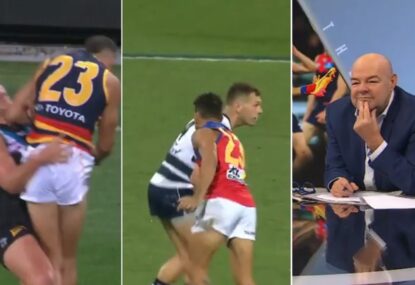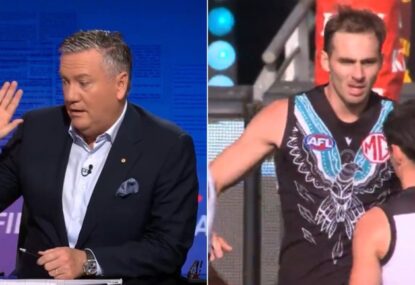The AFL’s father-son rule, however archaic, is a feature of the game which must be preserved, not abolished or limited under the guise of equalisation.
I cannot say the same for the modern academy programs established by the northern-state clubs.
Gillon McLachlan forecast wholesale changes to the father-son and academy bidding process late last year. He provided little comment other than, “it’s so mathematically based it blows your head off”.
Andrew Demetriou spent the last decade navigating the treacherous path of equalisation. When one looks back at the Demetriou administration, many will regard his legacy as the establishment of Greater Western Sydney and the Gold Coast Suns. Equally, he can boast that none of the foundation clubs disbanded or merged despite financial difficulty.
McLachlan is faced with the same challenge of managing equalisation among the 18 teams. The vehicle in which he proposes to tackle equalisation first up? The father-son rule and the player academies.
The details at this stage are scant, however a system is being devised to force clubs to pay ‘true’ market value for father-son and academy players selected in the AFL National Draft. It involves establishing a Draft Value Index in which each pick in the National Draft is assigned a number of points, as if it were a currency that can be exchanged for a player.
Clubs that seek to draft their academy players or father-son selections are entitled to a 25 per cent and 15 per cent discount respectively.
The first example provided on the AFL website is the drafting of Isaac Heeney, a Sydney Swans academy player touted as a number one prospect in last year’s National Draft.
Melbourne made a bid of pick two to try and secure the services of the talented midfielder. Under the old system, Sydney matched the bid and were therefore forced to use their next pick, pick 18, to draft Heeney. As a result, the perception in the footballing world was that the Sydney Swans were unjustly enriched, effectively securing a top-three draft prospect for pick 18.
Under the proposed system, Sydney would have had to have given up multiple draft picks to acquire Heeney.
As Melbourne bid pick two, Sydney would have to give up 2,517 points (as set out in the Draft Index table of values) less the 25 per cent academy discount to draft Heeney, being 1,888 points. Sydney had picks 18, 37 and 38 which are assigned 985, 483 and 465 points respectively in the Draft Value Index.
This means that Sydney would use pick 18 and 37 which represents 985 + 483 = 1,468 points. Sydney must give up a further 420 points to acquire Heeney. These points are taken from their next selection, pick 38, which is worth 465 points. The remaining 45 points results in Sydney’s 38th pick moving to pick 70 as determined by the Draft Value Index.
How exactly the points have been assigned to the draft picks is unclear, but the AFL website reveals that a statistical analysis of players’ salaries from 2000 to 2014 has been used to assign the number of points each pick is worth. Given the uproar surrounding the lack of transparency in relation to free agency compensation, more information would want to be provided on this point.
It is troubling that such an important aspect of the draft can be based on a criterion which often has little correlation with the value of a player. For example, former number 1 draft pick Tom Scully is one of the highest-paid players in the league, but with all due respect, there are several players whom clubs would deem more valuable than Scully irrespective of where they were taken in the draft and their pay packet.
Ultimately, the policy behind the changes to the father-son and academy rules are related to equalisation, and therein lies the problem.
The father-son rule as a concept has nothing to do with equalisation – it is a romantic aspect of the game which connects generations of players, fans and clubs.
In the case of academy-selected players, adjusting the value which a club pays to obtain the services of one seems reasonable. The academy process was brought in to increase participation in non-AFL centric states at junior level, not to provide the northern clubs with a competitive advantage.
Conversely, every club, with perhaps the exception of GWS and the Gold Coast Suns, is in an equal position under the father-son rule. Some clubs may have benefitted more than others in the past, but ultimately it comes down to chance and unknown genetic factors. Many Essendon and Carlton supporters would be eagerly anticipating the arrival of another Hird or Silvagni. And frankly, given the recent dominance of Hawthorn, Geelong and Sydney, West Coast and the Brisbane Lions throughout the 2000s, there is no empirical evidence that the equalisation measures implemented over the last 20 years actually work.
The father-son rule, however quaint, is one of the great aspects of our game. In an era where we lament change, have a peculiar nostalgia for many aspects of it which are long gone, such as suburban grounds, simple rules and player/club loyalty, preserving the father-son rule must be a priority.



































































































